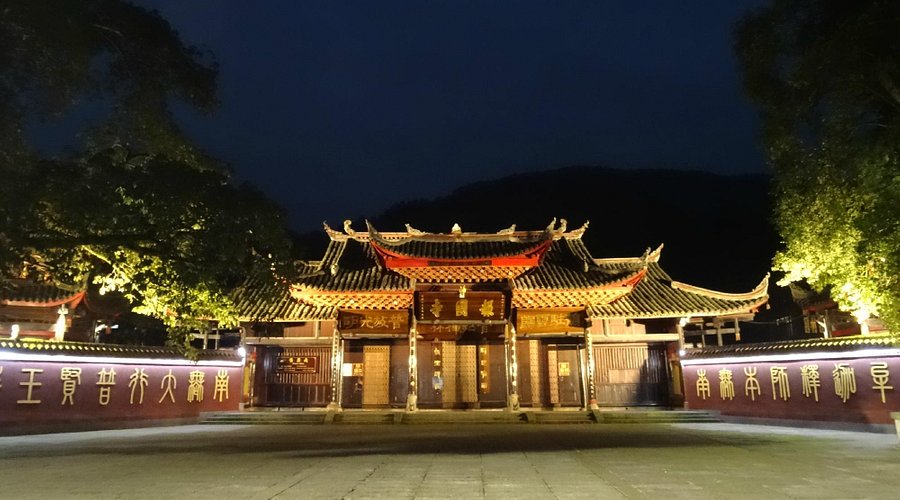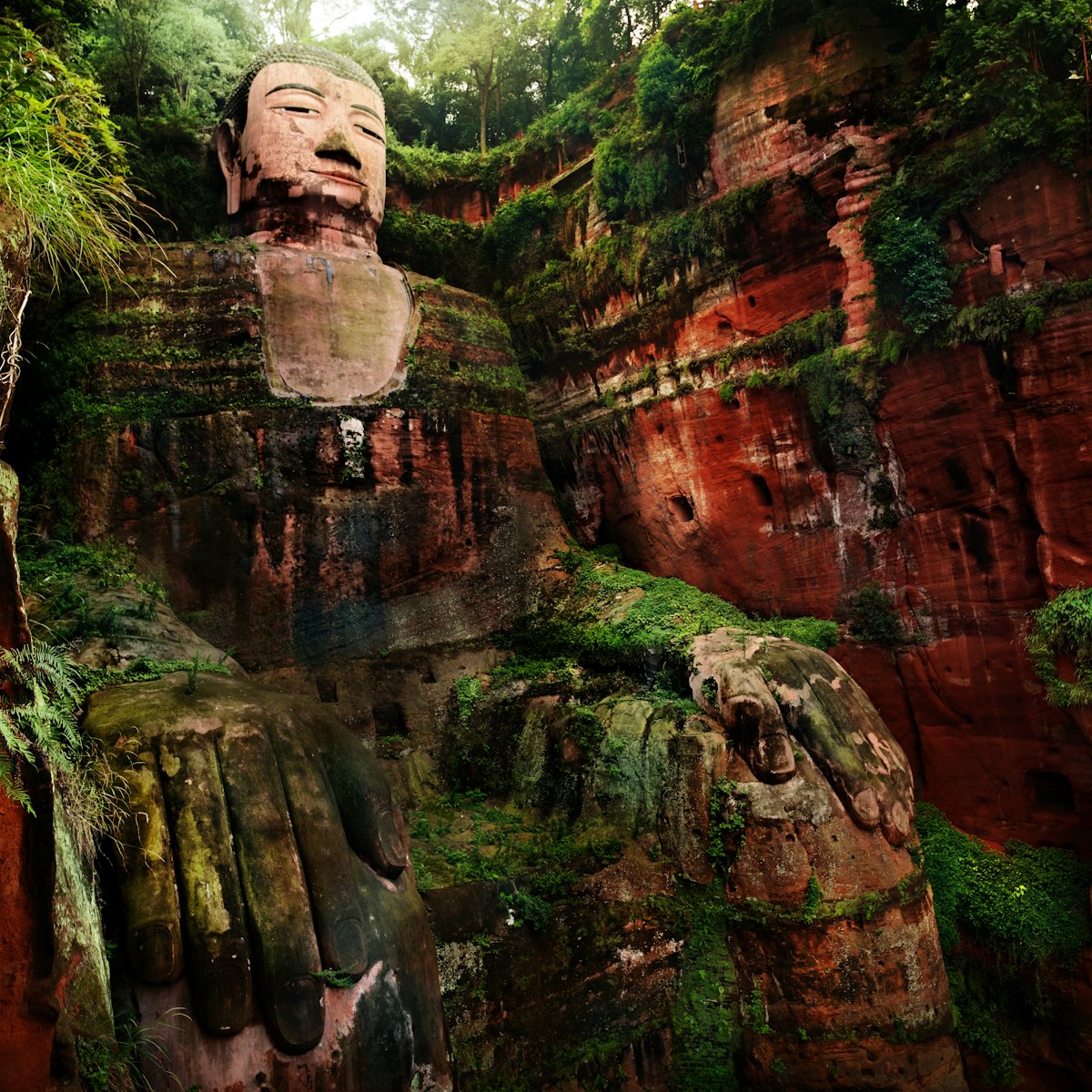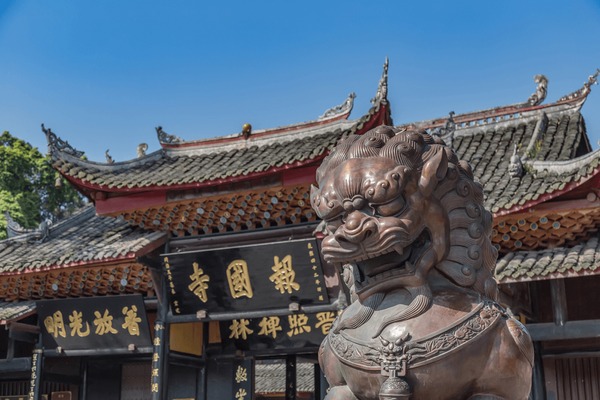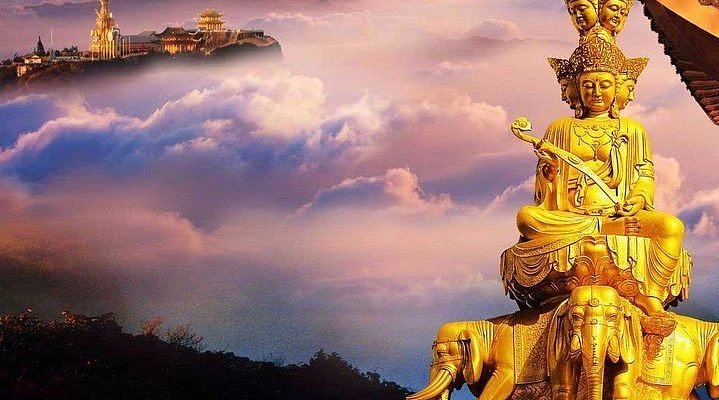Experience the Tranquility of Baoguo Temple: Tips for Travelers

An Essential Guide to Visiting Baoguo Temple
Nestled at the foot of the majestic Emei Mountain, Baoguo Temple (保国寺) stands as a tranquil testament to the rich tapestry of Chinese Buddhist culture. As the largest temple on Emei, it serves not only as a spiritual haven but also as a gateway to the breathtaking landscapes and sacred sites that this UNESCO World Heritage area has to offer.
Visitors are greeted by a serene courtyard adorned with vibrant stalls offering local snacks and crafts, creating a lively atmosphere that contrasts beautifully with the temple’s peaceful ambiance. The architecture, an intricate blend of ancient design and spiritual significance, invites exploration and contemplation.
Whether you’re drawn by the allure of its porcelain Buddha, crafted in the renowned kilns of Jingdezhen, or seeking a moment of meditation in its lush gardens, Baoguo Temple offers an experience that transcends the ordinary. As you step into this sacred space, let the gentle sounds of prayer and the whispers of history guide you, making your visit a memorable chapter of your travels in China.
In This Guide
- An Essential Guide to Visiting Baoguo Temple
- The Rich History and Legends of Baoguo Temple
- Main Highlights: What You Absolutely Can’t Miss
- Planning Your Visit: A Practical Guide
- Tickets: Prices, Booking, and Tips
- How to Get There: A Complete Transportation Guide
- Local Cuisine and Accommodation Nearby
- Frequently Asked Questions
- Final Thoughts on Your Trip
The Rich History and Legends of Baoguo Temple
Nestled at the foot of the majestic Emei Mountain, Baoguo Temple (保国寺) stands as a testament to the rich tapestry of history, culture, and spirituality that defines this sacred site. Founded during the Tang Dynasty (618-907 AD), it is the largest temple in the Emei Mountain area and has long served as a pivotal center for Buddhist activity. Its name, which translates to “Preserving the Nation,” reflects its historical significance as a bastion of Buddhist teachings and practices.
Over the centuries, Baoguo Temple has witnessed numerous historical events, including various dynastic changes, wars, and the evolution of Chinese Buddhism. It played a crucial role in the dissemination of Buddhist philosophy and was a training ground for many monks who would go on to influence the spiritual landscape of China. The temple’s architecture, with its intricate wooden carvings and serene courtyards, embodies the artistry of ancient Chinese craftsmanship. The temple complex features impressive structures such as the main hall, adorned with a stunning porcelain Buddha crafted in the renowned Jingdezhen kilns, a symbol of the temple’s artistic heritage.
Legends abound in the rich narrative of Baoguo Temple. One popular tale recounts how the temple was blessed by the Bodhisattva Samantabhadra, who is said to have descended from the mountain to protect the temple and its practitioners. This divine connection has made Baoguo Temple not only a place of worship but also a pilgrimage site for devotees seeking spiritual solace and enlightenment. Visitors can often hear the soft chants of monks and the gentle ringing of bells, enhancing the temple’s tranquil atmosphere.
As you wander through the temple grounds, you will find a large courtyard that serves as a gathering place for pilgrims and tourists alike. It is surrounded by lush gardens, where you can experience a moment of peace away from the bustling tourist town nearby. The temple’s serene environment invites reflection and introspection, allowing visitors to connect with the spiritual essence of the site.
Today, Baoguo Temple remains a vital link to the past, offering a glimpse into the profound history and legends that shape its identity. For international travelers, a visit to this sacred temple is not just a journey through stunning landscapes but also an opportunity to delve into the rich cultural heritage of China and the enduring legacy of Buddhism. Whether you seek spiritual growth, historical insight, or simply a moment of tranquility, Baoguo Temple promises a meaningful experience that resonates deeply with all who visit.

Baoguo Temple.
Main Highlights: What You Absolutely Can’t Miss
Baoguo Temple, nestled at the foot of Emei Mountain, is a must-visit destination for anyone exploring this serene region of China. Here are the highlights that you absolutely cannot miss during your visit:
The Serene Courtyard
As you enter Baoguo Temple, you’ll be greeted by a large, tranquil courtyard that sets the tone for your experience. This expansive space is often bustling with vendors selling local delicacies and souvenirs, including bags of fresh fruit. Take a moment to stroll around, breathe in the fresh mountain air, and soak in the peaceful atmosphere.
Architectural Marvels
Baoguo Temple is known for its stunning architecture, reflecting traditional Chinese design. The intricate details and beautiful carvings on the temple buildings provide a glimpse into the rich cultural and religious history of the site. Don’t forget to capture the beauty of the porcelain Buddha, crafted in the renowned imperial furnaces of Jingdezhen, which is a highlight within the temple.
Peaceful Gardens
Adjacent to the temple, you’ll find beautifully maintained gardens that offer a quiet retreat for reflection and meditation. The lush greenery and serene paths invite you to take a leisurely stroll, allowing you to escape the hustle and bustle of nearby tourist attractions. The gardens are an ideal place to relax and appreciate the tranquil ambiance of your surroundings.
Buddhist Practices
If you’re interested in understanding local traditions, you might witness monks engaging in rituals and prayers throughout your visit. Baoguo Temple is a center for Buddhist activity, and observing these practices can provide meaningful insights into the spiritual life of the area. Feel free to join in or simply observe respectfully from a distance.
Nearby Attractions
While at Baoguo Temple, consider exploring other nearby sites such as Fuhu Temple and the Emeishan Museum, both of which are within walking distance. These attractions offer additional layers of historical context and beauty to your journey through this sacred region.
Unique Overnight Experience
For those seeking a deeper connection to the temple, consider an overnight stay. The accommodations are simple but comfortable, arranged around a small courtyard. This unique experience allows you to immerse yourself in the peaceful environment, waking up to the sounds of morning prayers—a truly memorable way to connect with the spiritual essence of Baoguo Temple.
Local Cuisine
After exploring, treat yourself to some local cuisine. Just a short walk from the temple, you’ll find a variety of restaurants and stalls offering delicious Sichuan dishes. Sampling the local flavors will round out your experience beautifully.
Conclusion
Baoguo Temple is more than just a religious site; it’s a serene sanctuary that captures the essence of Emei Mountain’s spiritual heritage. From its tranquil courtyard and stunning architecture to its peaceful gardens and rich cultural practices, every corner offers something special. Whether you’re looking for spiritual enrichment, historical insights, or simply a place to unwind, Baoguo Temple is a destination you won’t want to miss.

Baoguo Temple.
Planning Your Visit: A Practical Guide
When planning a visit to Baoguo Temple (保国寺), the largest temple at the foot of Mount Emei, you’re in for a serene experience steeped in history and spirituality. Here’s everything you need to know to make the most of your visit.
Getting There
Baoguo Temple is conveniently located at the foot of Mount Emei, making it easily accessible for travelers. If you’re coming from Chengdu, a popular route is to take a bus or book a private transfer. The temple is approximately 150 kilometers (about 93 miles) from Chengdu, with travel times typically ranging from two to three hours depending on traffic.
Opening Hours
The temple is open daily from 8:00 AM to 6:00 PM. It’s advisable to arrive early to avoid the crowds and fully appreciate the tranquil atmosphere.
Admission Fees
While there is no specific admission fee for entering Baoguo Temple, you may need to pay for certain activities or experiences within the temple grounds, such as offerings or guided tours. Always check for any updates on fees before your visit.
What to Expect
Upon arrival, you will be greeted by a large courtyard where vendors sell local snacks and souvenirs, creating a lively yet peaceful atmosphere. The temple itself is known for its beautiful architecture and serene gardens, which provide perfect spots for reflection and photography.
Visitors often mention the calming influence of the temple and the opportunity to witness traditional Buddhist practices. You may even hear the gentle sounds of monks chanting, adding to the spiritual ambiance.
Activities
- Explore the Temple Grounds: Take your time to wander through the temple complex. The architecture, including the intricately carved wooden structures, is a sight to behold.
- Participate in Prayer: If you’re interested, you can join in prayer or offer incense, which is a common practice among visitors.
- Enjoy the Gardens: The surrounding gardens are peaceful and provide a lovely backdrop for a leisurely walk or quiet contemplation.
- Visit Nearby Attractions: Don’t miss other nearby attractions such as Fuhu Temple and the Emeishan Museum, both within a couple of miles of Baoguo Temple.
Accommodation
For those wanting to immerse themselves fully in the spiritual experience, there are lodging options near or within the temple grounds. Staying overnight allows you to enjoy the tranquility of the temple in the early morning hours and participate in morning prayers. Be prepared for basic amenities, including shared facilities.
Dining Options
While there are no extensive dining options within the temple, the bustling town nearby offers a variety of restaurants, from local eateries to more upscale dining. Try some Sichuan dishes, such as hot pot or dumplings, to complete your experience.
Tips for Your Visit
- Dress Respectfully: As a place of worship, it’s important to dress modestly. Comfortable shoes are also recommended as there may be a fair amount of walking involved.
- Be Mindful of Photography: While photography is allowed in many areas, be respectful of areas where it may be prohibited, especially during prayers.
- Stay Hydrated: If you plan to hike around Mount Emei after your temple visit, bring plenty of water and snacks to keep your energy up.
Conclusion
A visit to Baoguo Temple offers a unique opportunity to delve into the spiritual heart of Mount Emei. With its serene environment, rich history, and accessibility, it’s a perfect stop for international travelers looking to experience the beauty of Chinese culture and Buddhism. Prepare to be enchanted by the tranquility and beauty of this remarkable temple.

Baoguo Temple.
Tickets: Prices, Booking, and Tips
Visiting Baoguo Temple is a serene experience that connects you with the spiritual essence of Emei Mountain. Here’s everything you need to know about ticket prices, booking options, and helpful tips for making the most out of your visit.
Admission Details
As of now, entry to Baoguo Temple is generally free of charge. This makes it an accessible destination for travelers keen on exploring its tranquil environment and stunning architecture without the burden of an entrance fee. However, if you plan to participate in any special ceremonies or guided tours, there may be additional costs associated with those experiences.
Booking Tips
-
Plan Your Visit: The temple is open daily from 8:00 AM to 6:00 PM. Arriving early allows you to enjoy the peaceful surroundings before the crowds arrive, making for a more reflective experience.
-
Consider Guided Tours: While the temple itself is free to enter, you might want to consider booking a guided tour that includes Baoguo Temple as part of a larger itinerary. Tours often include transportation and insights from knowledgeable guides, enhancing your understanding of the temple’s significance.
-
Check for Group Rates: If you are traveling with a group, inquire about special rates or arrangements that might be available for larger parties. This can help make the experience more affordable and enjoyable for everyone.
Additional Tips
-
Stay Nearby: For those who wish to immerse themselves in the experience, consider staying in nearby accommodations. There are options ranging from local guesthouses to more luxurious hotels. Some tours even offer overnight stays at monasteries, allowing you to wake up to the sound of morning prayers.
-
Respect the Environment: Baoguo Temple is a place of worship, so be mindful of your behavior and dress modestly. Photography may be restricted in certain areas, so always check for signs or ask for permission before taking photos.
-
Explore the Surroundings: After visiting the temple, take some time to stroll through the beautiful gardens and the local market stalls nearby. You’ll find traders selling local fruits and crafts, adding a vibrant touch to your visit.
By keeping these points in mind, you’ll be well-prepared to enjoy a fulfilling visit to Baoguo Temple, deepening your appreciation for its historical and cultural significance.
How to Get There: A Complete Transportation Guide
To embark on your journey to Baoguo Temple, nestled at the foot of Emei Mountain, you’ll find a variety of transportation options that cater to international travelers. Here’s everything you need to know to make your visit seamless and enjoyable.
Arriving in Chengdu
Most international travelers will begin their adventure in Chengdu, the capital of Sichuan Province, which is well-connected by air, train, and bus services. Chengdu Shuangliu International Airport is the primary gateway for international flights. From the airport, you can take a taxi, airport shuttle, or use ride-hailing apps to reach the city center.
Getting to Emeishan
Once in Chengdu, your next step is to reach Emeishan, where Baoguo Temple is located. There are several transportation options available:
1. By Train
- Chengdu to Emeishan Train Station: The fastest and most convenient way is to take a high-speed train from Chengdu East Railway Station to Emeishan Railway Station. The journey takes about 1.5 to 2 hours. Trains run frequently throughout the day, typically every 30 minutes to an hour. Be sure to check the schedule in advance and purchase tickets online or at the station.
- From Emeishan Railway Station: Once you arrive, you can take a taxi or local bus to Baoguo Temple. The temple is approximately 10 kilometers (6 miles) from the train station, and the ride should take around 20 minutes.
2. By Bus
- Chengdu to Emeishan City: Long-distance buses depart from several bus stations in Chengdu, including the Chengdu Xinnanmen Bus Station and the Chengdu Chadianzi Bus Station. The bus ride takes about 2 to 3 hours, depending on traffic.
- From Emeishan City to Baoguo Temple: After reaching Emeishan City, you can catch a local bus or a taxi to Baoguo Temple. Local buses are economical but may take longer; taxis are more direct and convenient.
Local Transportation
Once you arrive at Baoguo Temple, you’ll find the area is quite walkable. The temple itself features a lovely courtyard and gardens that are easily accessible. If you wish to explore further, consider renting a bike or using local taxis for nearby attractions.
Tips for Your Journey
- Language: English is not widely spoken in the region, so having a translation app or a phrasebook can be helpful.
- Cash: While larger establishments may accept credit cards, it’s a good idea to carry cash, especially for small purchases or local transport.
- Opening Hours: Baoguo Temple is open from 8:00 AM to 6:00 PM daily, so plan your visit accordingly.
With this comprehensive guide, you’re all set for an enriching experience at Baoguo Temple. Enjoy the serene atmosphere and the stunning natural beauty of Emei Mountain!

Baoguo Temple.
Local Cuisine and Accommodation Nearby
Nestled at the foot of the majestic Emei Mountain, Baoguo Temple is not just a spiritual haven but also a gateway to a delightful culinary and accommodation experience that caters to both local traditions and international tastes. After exploring the serene temple grounds, you’ll find plenty of options to satisfy your hunger and rest your weary legs.
Local Cuisine
While visiting Baoguo Temple, don’t miss the chance to sample authentic Sichuan cuisine, renowned for its bold flavors and spicy dishes. Just a short walk from the temple, Deng Loong Lou Restaurant stands out with its impeccable reviews. Known for its warm atmosphere and attentive service, this eatery offers a variety of local specialties, including:
- Mapo Tofu: A classic Sichuan dish featuring soft tofu in a spicy sauce made with fermented bean paste and Sichuan peppercorns, delivering a unique numbing sensation.
- Kung Pao Chicken: A stir-fried dish with chicken, peanuts, and vegetables, known for its savory and slightly sweet flavor.
- Hot Pot: For a communal dining experience, try a spicy hot pot where you can cook your selection of meats and vegetables right at the table.
You may also find small stalls near the temple selling local snacks like steamed buns and fresh fruit, perfect for a quick bite before continuing your exploration.
Accommodation Nearby
For those looking to immerse themselves further in the tranquil atmosphere of the area, staying overnight in nearby accommodations is highly recommended. The Baoguo Temple Monastery offers a unique experience, allowing guests to stay in simple yet comfortable quarters arranged around a charming courtyard. Here are a few highlights:
- Monastery Stay: Experience the peacefulness of the temple grounds by spending the night in dormitory-style rooms. While amenities are basic (with shared bathrooms and limited shower hours), the opportunity to wake up to the sounds of morning prayers is unparalleled.
- Local Guesthouses: Just a short stroll from the temple, you’ll find various guesthouses that cater to different budgets. Many offer cozy rooms along with traditional meals, providing a taste of local hospitality.
After a long day of exploring the spiritual and natural beauty of Emei Mountain, you’ll find that both the local cuisine and accommodation options around Baoguo Temple enhance your travel experience, allowing you to savor the essence of this enchanting region.

Baoguo Temple.
Frequently Asked Questions
Frequently Asked Questions about Baoguo Temple
1. What are the opening hours of Baoguo Temple?
Baoguo Temple is open daily from 8:00 AM to 6:00 PM. It’s a great idea to visit early in the day to enjoy the serene atmosphere and avoid the crowds.
2. How do I get to Baoguo Temple?
The temple is located at the foot of Emei Mountain in Emeishan, China. You can reach it by taking a bus from Chengdu, which is about 150 kilometers away. Local transportation options, including taxis and rideshares, are also available for convenience.
3. Is there an entrance fee to visit Baoguo Temple?
Currently, there is no specific entrance fee to visit Baoguo Temple itself, but note that you may need to pay for access to the surrounding Emei Mountain area.
4. What is the best time to visit Baoguo Temple?
The best time to visit is during the spring (March to May) and autumn (September to November) when the weather is mild and the scenery is especially beautiful. Early mornings are also recommended for a peaceful experience.
5. Are there any amenities available at or near the temple?
Yes, there are several amenities nearby, including stalls selling snacks and souvenirs. Additionally, there are options for lodging if you wish to stay overnight, providing a unique experience amidst the tranquil surroundings.
6. What should I wear when visiting Baoguo Temple?
It’s advisable to wear comfortable shoes suitable for walking, as you may encounter uneven paths and steps. Modest clothing is also recommended out of respect for the religious setting.
7. Can I take photographs inside Baoguo Temple?
Generally, photography is allowed in the temple grounds; however, be mindful of signs indicating restricted areas. It’s always best to ask for permission if you are unsure.
8. Is it possible to participate in any rituals or prayers at the temple?
Yes, visitors are welcome to participate in prayers and light incense at designated areas. This is a great way to immerse yourself in the local culture and spiritual practices.
Final Thoughts on Your Trip
As you conclude your journey to Baoguo Temple, take a moment to reflect on the serene beauty and rich history that envelops this sacred site. Nestled at the foot of the majestic Emei Mountain, this temple not only serves as a spiritual sanctuary but also as a gateway to the captivating wonders of Buddhist culture. The tranquil gardens, the sound of soft prayers, and the scent of incense create an ambiance that invites introspection and peace.
Whether you find solace in the temple’s architecture, enjoy a leisurely stroll through the picturesque surroundings, or engage with local vendors selling delightful snacks and crafts, Baoguo Temple offers a unique glimpse into the harmonious blend of nature and spirituality.
As you prepare to leave, let the memories of this peaceful retreat linger in your heart, inspiring you to carry a piece of its tranquility with you on your travels. Whether you’re seeking enlightenment or simply a moment of stillness, Baoguo Temple stands as a testament to the enduring allure of ancient traditions and the beauty of the natural world. Safe travels on your next adventure!